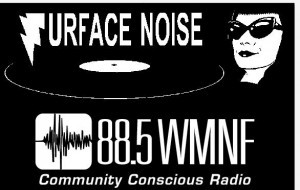
The University of South Florida, Tampa has issued a request for information to companies interested in developing a large area of land north of campus; but students and faculty are fighting the idea of altering the USF Forest Preserve.
WMNF spoke with Jeannie Mounger, a Ph.D. candidate in the Integrative Biology department at the University of South Florida. We spoke about the possible development of a large section of land north of the USF Tampa campus between Lettuce Lake Park and the Hillsborough River and the USF golf course (it’s called the Northern Property and includes “USF ecological research area” or “USF forest preserve”).
“Well, I first learned about the news from the [Tampa Bay Business Journal] article that was recently published, rather than hearing about it from the University or through the University system. And I brought this article up to several faculty members in my department, to see if they were familiar with this request for information for development plans of the USF Forest Preserve and the golf course. But no one I corresponded with was aware of it.
“I learned from faculty members of other departments, who also use the preserve for teaching and research, that they had similarly not been informed of this request. And it’s my understanding that according to the Master Plan document that was published within the university, that the preserve and the golf course are considered unavailable for development at least until that document is up for revision in 2025.”
WMNF requested an interview with USF, but it was not granted. USF spokesperson Adam Freeman wrote in a statement:
“Attached is a copy of the request for information (RFI). The primary goal of the RFI is for the university to explore options that might be available on the property. The RFI allows USF to gauge interest and obtain information to consider the best strategy for a potential project, such as the possibility of a ground lease, that could provide greater financial resources to support the university’s mission and benefit our students, faculty and staff. However, USF is not required to take action on any of the proposals submitted by developers.”
Mounger responded,
“Well, I think that the implication of potential development is pretty short-sighted. And possibly to that, even just the request for information or the search for potential ground leases is really being proposed without consideration for the faculty and the students, but also community partners who utilize the preserve, as well as the golf course, as a core university facility. And it seems to me that the University is perhaps unaware that the overwhelming majority of the preserve property is considered a designated wetland.
“From what I’ve seen of their proposal, they don’t seem to know that at least 550 of the 700 plus acres are either completely unbuildable or are trapped within wetland matrix of unbuildable land. So that leaves about a hundred and fifty acres of golf course land and 50 acres of buildable land within the preserve. And it’s really this 50 acres in the preserve that is such a valuable resource for teaching and for research in various departments within USF.
Why is the USF Forest Preserve important?
“Well, there’s really significant importance of this property as an integral resource and facility for several departments within USF, including my department, but also within geosciences, anthropology, public health, engineering, even the school architecture and community design. And so, within integrative biology, we currently have several graduate students who are conducting research within the preserve, including one PhD candidate who is investigating impacts of groundwater extraction to wetland ecohydrology, which is a particularly relevant topic to public stakeholders and citizens in the Tampa Bay area.
“We also run several undergraduate and graduate-level courses within the preserve. So, this includes anything from mammalogy, vertebrate natural history, herpetology, comparative vertebrate anatomy to field botany and wetlands ecology, and even our principles of ecology labs, just to name a few. There are several other courses that we run. And many of these courses would have to be completely restructured if we were to lose this resource. They really are invested in the resource as a teaching tool.
“In addition to that, our biodiversity lab, which is a core course for anyone pursuing a biomedical or biology degree at USF. This is a course that’s taught across 30 sections to 800 undergraduate students per semester. And we use that preserve as a basis for several specimen collections that we’ve then use as teaching tools for that course. Which is — if you want to look at it from a money-making perspective, which I think is what USF is interested in — this is a huge component of a major set of degrees that are available at the University.
“And so, I think, for those of us in integrative biology, the loss of this resource would really significantly diminish our ability to engage with our students. It would diminish our ability to provide them with opportunities for practical applications of scientific research methods. I can go on. I have lots to say about this topic from a very personal perspective. I’ve seen and experienced the joy that learning in this environment brings students. It brings me joy as an educator to bring students out there, and to see their faces light up when they get a look at the dynamics of ecology up close.
“I teach field botany. And we have a significant outdoor classroom component to that course, of which the USF forest service is a really critical part of that teaching style. And you can just really, you can really feel the excitement that students have being able to engage with nature in that way. I think in a lot of cases, these experiences become the catalyst for students to pursue graduate degrees, or to pursue careers in the sciences, or science policy and conservation. This resource, and being able to teach at it, is such an important component of what we do in our department.
“Christian Brown — who is another Ph.D. candidate in my department — he teaches mammalogy and herpetology. And he often speaks about the way students light up and engage when they get the chance to go out there, and see an otter for the first time, or hold their very first snake. It really does create these lifelong bonds with nature that just can’t be replicated in the classroom.”
What is the USF Forest Preserve like?
“Well, when you first walk in from Fletcher Avenue, you walk into a sandhill habitat, which is a fairly imperiled habitat now in the state of Florida. Largely because it’s prime real estate for development because it’s higher ground. But these habitats are really fascinating and contain a lot of endemic species, a lot of listed endangered species. So, you’d see longleaf pines. You’d see gopher tortoises. You’d see a lot of fascinating plant life that is specially adapted to this sandhill ecosystem. We actually have inventoried several listed endangered plant species within the preserve, and that includes things like native and endemic orchids, rain lilies, bromeliads, milkweeds and several other species.
“So, you walk through the sandhill, and then as you walk further north, you end up in a really tremendous wetland area. And this preserve is part of a really significant wildlife corridor that stretches from — essentially — urban Tampa all the way up to the Green Swamp. And the Green Swamp is a significant corridor for wildlife throughout the entire state of Florida. So, this piece of property is very, very important for all kinds of wildlife that relies on the Hillsborough River Watershed. And it would just be rather devastating to lose this particular piece of property.
“Within the master plan document that the University put forth, they actually lay out that an expansion of green space is needed, rather than a reduction of green space in this area. These ecosystems, both the sandhill habitat, but particularly the wetlands, provide what we call ecosystem services. So, they’re important in mitigating flooding, as well as in clean water, clean air, and they’re also significantly important component to sequestering greenhouse gas emissions. So, the University is talking about the value, of the potential value, of this piece of property as it can be transformed. But the property, as it is now is incredibly valuable to the community of Tampa Bay and to the state of Florida.”
In its request for information, USF says, “The forest preserve is used for student and faculty research. More than 70 research papers in peer‐reviewed literature have been focused on the forest preserve, as have more than 20 M.S. theses and Ph.D. dissertations.”
What would you like to happen to the USF Forest Preserve?
“Well, I think the best use of the preserve is, as it exists currently. But, I would go even further to say that I think that additional money should be invested into the preserve. We often try to perform prescribed burns on the properties, particularly the sandhill habitat, because it is a habitat that is driven by fire. And a lot of the plants rely on seasonal fire to persist. And it’s been increasingly difficult, for instance, for us to perform those prescribed burns because of increased encroachment from urbanization. We think that potentially having a land manager that is specific to this piece of property would really benefit the University. It would benefit the students and researchers, and really make this ecosystem even more valuable than it then it is currently, as part of this Wildlife Corridor, and this really important place for research.”
Native American burial sites and indigenous cultural items
“The general position is that we are strongly opposed to any plans to develop this property. Hearing from Anthropology, I learned as well, that there are Native American burial sites on his property, as well as significant indigenous cultural items. And so, just taking the ecological component and the archaeological component into consideration, what we see is that USF could potentially, not only be breaking their binding agreement in this master plan, but they may be looking at running counter to several state and federal regulations.
“There are numerous regulatory laws related to environmental and archaeological resources protection that the University is required to adhere to, and which development is completely incongruous with. So, I would say from the people in several departments that I’ve spoken to, that the unified voice is we are very opposed to any developments.
“Currently, there are actions being taken within the University system. And I think once those play out, that we’ll see where the University is interested in going with this proposal and, you know, just play it by ear as things develop.
“I certainly want to drive home again that while this is an important place for researchers and students at USF, it’s also important for the community, as I said before, because of its mitigating factors, because of the ecological functions that it performs for the greater community. I think it’s really important that the citizens of Tampa Bay understand how valuable this ecosystem is to them, even if they’re not actively involved in research or study within it.”
Watch the interview here:















